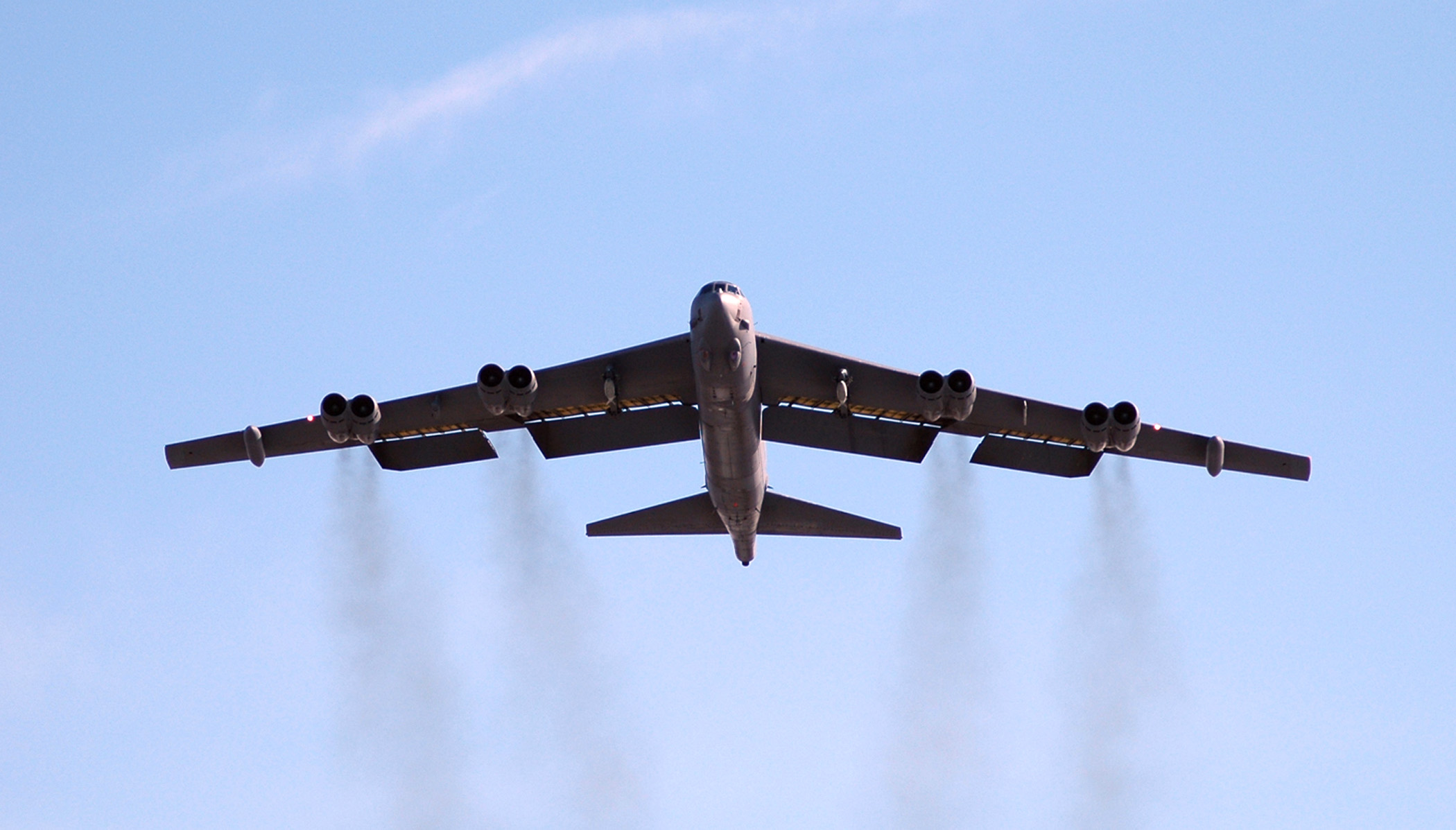A B-52 Stratofortress from the 93rd Bomb Squadron at Barksdale AFB, La., takes off from Eieslon AFB, Alaska, during Red Flag-Alaska. Air Force photo by TSgt. Jeff Walston.
Rolls-Royce is “seeing a lot of momentum building” within the Air Force for the idea of re-engining the B-52 fleet, company senior vice president for customer business Tom Hartmann said Thursday, laying out the company’s offering of the BR725 powerplant—military designation F130—for the job.
In a telecon with aerospace reporters, Hartmann said Rolls sees an “imminent” announcement from the Air Force in the form of a new request for information from industry about what engines could fit the bill for a one-for-one re-engining of the B-52’s ancient Pratt & Whitney TF33-P3 engines, although he acknowledged that there is—as of Thursday—no stated program of record for such a project.
As early as 1982, the Air Force looked at re-engining the veteran airplanes, looking for improvements in range, fuel burn, and in reducing the smokiness of the original powerplants. In recent years, despite the advocacy of people such as Vice Chief of Staff Gen. Stephen Wilson, B-52 re-engining has been described by top USAF officials as falling just outside the list of affordable priorities.
In recent “industry day” discussions and in a request for information, the Air Force has specified it would be looking for a one-third improvement in fuel efficiency and a 40-percent improvement in range, along with substantially less maintenance requirements. Hartmann said the BR725’s “time on wing” between overhauls is so long that if it was put on the B-52, no overhaul would be necessary before the jets retire, which Hartmann reported would not come before “the 2050s.” The Air Force also wants a “green” improvement, and the F130 would produce only five percent as much carbon as the TF33s, Hartmann said. The re-engining “would pay for itself in about 10 years,” he asserted, due to reduced fuel and maintenance costs, and by skipping overhauls of the TF33s.
The Air Force has previously discussed with industry the idea of creative funding models on a potential B-52 re-engining, and Hartmann said there have been talks with the service about “financing” and potential “lease-type arrangements” of the engines. If the company wins such work, Hartmann said Rolls will build a facility in the US to assemble and service the engines. Manufacturing of the BR725 would continue in Germany.
The F130 would incorporate lessons learned from the 700 series of Rolls engines as well as its Trent commercial powerplant. The engine is already in USAF service aboard the RQ-4 Global Hawk, the E-111 BACN, and has been chosen to power the new Compass Call aircraft, the Gulfstream G650. Hartmann said the Air Force is looking for about 650 engines in total to equip a fleet of 72-75 B-52s.
In an interview with Air Force Magazine Thursday, John Robinson said USAF is looking at an eight-engine replacement for the eight-engine B-52 for a lot of reasons. “They looked at going with four” engines to replace eight, said Robinson, Boeing’s director of Air Force Integration & Strategic Systems, but doing so would create airframe issues the service would rather not get into. Some of these had to be addressed when USAF put physically larger engines on the KC-135. On the B-52, he said, these would include “adverse yaw” and a “re-engineering of the rudder” and a re-wiring of the throttle system in the pylons and cockpit. A larger fan that would replace two engines at a time would also pose issues for ground clearance, Robinson said, as well as the need to re-certify a lot of weapons that would have to clear the larger powerplants when released from wing pylons. Maintenance would be easier with eight engines as well, he said.
He reported that USAF’s first request for information on the B-52 re-engining was “several months ago.”
Robinson said Boeing has not formed a partnership with any engine company on a package deal for the re-engining, but said USAF is, at this stage, looking both for an “integrator” of the system as well as an engine vendor. As the original equipment manufacturer, Robinson said, Boeing believes it has a good chance at the integration work. His understanding is that the Air Force will compete engines of a similar class and choose a “best value” solution. It is not clear if the AIr Force would conduct the engine competition or leave it to whatever company is chosen as the integrator.
As to how long the work would take, Robinson’s answer was: “It depends.” The Air Force has already embarked on a radar modernization effort for the B-52 and it would have to figure out a way to keep enough bombers available for combat while performing programmed depot maintenance, the engine replacement, and other service.

